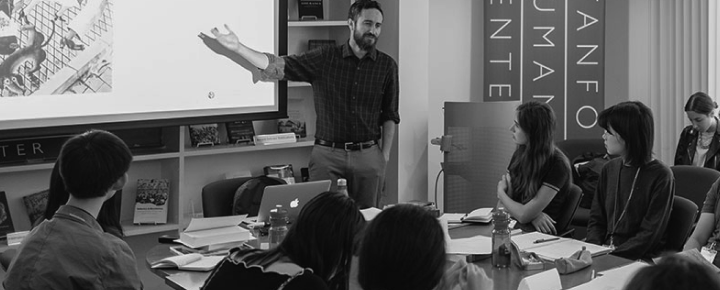Undergraduate Research Assistantships
Research Assistants for 2023-24
The Stanford Humanities Center offers research opportunities for Stanford undergraduates throughout the year. Research Assistants (RA's) work directly with Humanities Center fellows on faculty-led projects and build skills to conduct humanities research. Research opportunities are available during the winter and spring quarters only. The application process calls for a CV and a letter of interest, which should include a list of courses relevant to the project. Please send your application materials directly to the faculty mentor leading the research project. If you have questions, email (sturetsk@stanford.edu) Svetlana Turetskaya, International and Academic Programs Manager.
Research Projects
(1) Project Title: Historical Wonders: Jewish Jihads and Jewish Miracles in the Ottoman Empire
Faculty Leader: Orit Bashkin, University of Chicago/ Stanford Humanities Center External Faculty Fellow, oritb@stanford.edu
Project Description: The project studies how religious minorities understand the politics, histories, and religions of the majority community and how they make political and military victories of the empires and states in which they reside their own. Exploring the history of Jewish communities in the Ottoman Empire, the project suggests that Jews not only favored Ottoman rule, in its imperial and local forms, for geopolitical reasons, but also perceived Ottoman military victories and Ottoman politics as components of a Divine plan. Based on Hebrew, Arabic, and Judeo-Arabic texts from the 16th century to the 20th, such as liturgical poems, travel accounts, chronicles, and works of narrative prose, that were rarely, if at all, discussed in Western languages, the project aims to reconstruct local, often subaltern, perceptions of imperial subjectivity, told not from the vantage point of politicians, writers and scribes in the imperial center, but of a minority community who lived in the Empire. These texts reflect ecumenical and pan-Ottoman traditions circulating in different Muslim, Jewish, and Christian spheres, on the one hand, and functioned as vernacular histories that challenge the ways in which the imperial center conceptualized the relations between Jews and Muslims, on the other.
URA Responsibilities and Outcomes: The RA will gain an enhanced knowledge of the early modern and modern periods, Ottoman history, Arab history, and Jewish history and will have the chance to work with materials written by Jews from the 16th to the 19th century in Arabic, Judeo Arabic, and Hebrew. The RA will also gain familiarity with digital archives and collections pertinent to Jewish, Arab, and Ottoman history. The RA will be: (1) scanning texts from Stanford Library, (2) checking out library books, (3) copyediting book chapters, (4) If possible: going over translations from Hebrew and Arabic. There is no set of requirements for this project, but preference will be given to candidates who know either Hebrew or Arabic and candidates who are in the humanities or social sciences.
(2) Project Title: The Universal Race: Garveyism and the Practices of Pan-Africanism
Faculty Leader: Adom Getachew, University of Chicago/Stanford Humanities Center External Faculty Fellow, adom@stanford.edu
Project Description: This project examines the intellectual origins and political practices of Garveyism, the largest black mass movement of the twentieth century with six million members across the United States, the Caribbean, as well as West and Southern Africa. The wider book project aims to track two dimensions of the project. First, it seeks to situate the ideological and political visions of Garveyism in the transformations of the British Empire and the calcification of international racial hierarchy beginning at the turn of the twentieth century. Second, it seeks to situate Garveyism as a modern mass movement akin to socialist, labor, and nationalist formations of its time. Through this dual approach, Garveyism is pictured as an interregnum formation. It carried into twentieth-century Victorian ideals of self-help and improvement. It also built on and reignited the dream of African redemption championed by advocates of emigration in the nineteenth century. At the same time, Garveyism marked the reconstitution of Pan-Africanism as a mass movement. Garveyites self-consciously embraced the project of building a mass movement, which entailed a commitment to strategies and practices of transforming the “mass” into an agent of politics.
URA Responsibilities and Learning Outcomes: The RA will have the opportunity to engage in historical research and analysis including both primary sources and secondary sources. Specifically, the RA will be charged with working with digitized newspapers from colonial West Africa. They will learn how to identify keywords and track patterns over the course of the first two decades of the twentieth century. They will gather relevant articles and write short notes about content. Additionally, they will conduct research in the secondary scholarly literature. They will learn how to assemble a bibliography for a given area of research and develop literature reviews on specific topics. No language beyond English is required. A student interested in the history of race and empire, and/or African and Caribbean history will find this work most worthwhile.
(3) Project Title: Transregional Diaspora: Reconceptualizing Global Labor Flows Through the Lens of Bihar
Faculty Leader: Roanne Kantor, Stanford University, Stanford Humanities Center Internal Faculty Fellow, roannekantor@stanford.edu
Project Description: According to a 2019 United Nations report, the Indian diaspora is the world's largest diaspora, with a population of 17.5 million. A major part of this diaspora traces its origins to a region of the Indian subcontinent that is now known as Bihar. Bihar is also one of the largest sources of internal labor migration within India. The “transregional” framework allows us to think together on various scales—regional and global, rural and urban—and a rich range of historical, cultural, economic, and political narratives. The concept of diaspora illuminates interconnected stories of forced and voluntary migration through various stages of racial capitalism, and community identity and resilience. This project brings together scholars working in literature (Roanne Kantor), Art and Art History (Usha Iyer), and History (Parthapratim Shil). The exceptionally widespread of Bihari labor means that this exploration must build new intellectual networks across otherwise siloed areas, including South Asia, the Persian Gulf and Arabian Peninsula, the Indian Ocean, the South Seas, and the Caribbean, as well as “double-diaspora” populations that have since moved from these regions to the UK, the US, and Canada. In addition to this geographic breadth, a full understanding of the conditions of transregional diaspora requires delving into the last two hundred years of labor migration history. The project will shine new light on urgent social questions of economic and ethnic marginalization in this community while developing insights that will be applicable to other transregional diasporic communities.
URA Responsibilities and Learning Outcomes: The RA will help develop the technical infrastructure for the public-facing digital humanities mapping project. One layer of the map would function as a timeline emphasizing the geographic spread of the Bihari labor diaspora and the sheer volume of population transfer. The RA will also assist with the digital project to include links to visual, literary, and media representations of the transregional diaspora in various sites, trace cultural flows among diaspora sites, and visualize family or individual histories of diaspora and “double diaspora” across various regional contexts. The RA will also work on a comprehensive bibliography for the project across disciplines and regional contexts. The RA will compile information about emigration from Bihar in the colonial period from primary sources. In addition, they will help identify and then begin building out the digital platform with the greatest functionality for the project. Supervision would include regular meetings with the faculty mentor and bi-monthly meetings with the larger research team, in addition to mentoring through CESTA.
(4) Project Title: Translatio and Doctrīna: Natural Science and the Indies of the West
Faculty Leader: Jaime Marroquín Arredondo, Western Oregon University/Stanford Humanities Center External Faculty Fellow, marroq@stanford.edu
Project Description: This is a longue durée history of the colonial translations of Mesoamerican naturalist knowledges and their relation with the development of natural science. The research hypothesis is that colonial translation studies were key for an emerging understanding of the geographic and climatic regions of the planet, and their interactions at a global scale. The project intends to broaden current historical and historiographical analyses of naturalist scientific disciplines, many of which remain mostly indifferent to the colonial roots of modern science. Data gathering and translation of Indigenous knowledge about the landscapes of the tropical Americas, the most diverse in the world, remains an overlooked catalyst for the development of foundational paradigms of early modern natural sciences. To mention one key example, Alexander von Humboldt’s famous zonation of plants according to latitude and altitude was vastly informed by naturalist sources from Indies.
URA Responsibilities and Learning Outcomes: The RA will help in reading select sources and taking notes, following up on research leads, and locating primary and secondary sources at Green Library and online. The assistant will elaborate annotated bibliographies, including a one-sentence summary of topic and/or thesis for each entry. These subject-based bibliographies will be compiled through specific research questions that need to be addressed (i.e. how did Jesuit botanical knowledge from the Hispanic Americas was disseminated in 18th century central Europe?). The RA must be able to read Spanish at a high level. Archive research experience and familiarity in digital humanities research tools are highly desirable. Through collaboration in this research, the RA will sharpen research skills and develop a stronger sense of how primary and secondary sources about colonial history can be located, read, and interpreted. Through this work the assistant will also come to a deeper understanding of early modern science history, Mesoamerica and colonial Mexico.




